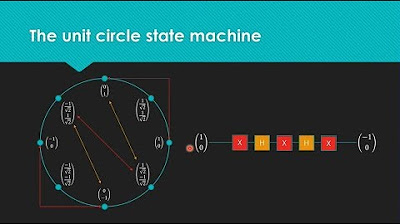How Quantum Computers Break Encryption | Shor's Algorithm Explained
TLDRThe video script discusses the critical role of encryption in securing data, emphasizing the reliance on the difficulty of factoring large numbers into primes. It introduces Shor's Algorithm, a quantum computing method that could potentially undermine current encryption systems by efficiently finding factors of large numbers. The script explains the mathematical concepts and quantum mechanics behind Shor's Algorithm, highlighting its potential to break encryption but also reassuring viewers that current quantum computing capabilities are limited. It concludes with a practical tip on enhancing internet security using a password manager like Dashlane.
Takeaways
- 🔐 The fundamental goal of encryption is to protect data in a way that only the intended recipient can access it.
- 🧱 The security of encrypted data on the internet largely depends on the difficulty of factoring large numbers using classical computers.
- ⏳ Finding the prime factors of a large number is computationally intensive and can take an extremely long time with current technology.
- 🌀 Shor's Algorithm is a quantum algorithm that can efficiently factor large numbers, posing a potential threat to internet security.
- 🥼 Quantum superposition and interference are the principles utilized by Shor's Algorithm to find factors rapidly.
- 🔄 Shor's Algorithm starts with a random guess and transforms it into a better guess that likely shares a factor with the target number.
- 📈 The algorithm exploits the mathematical fact that multiplying a number by itself repeatedly will eventually result in a multiple of another number plus one.
- 🤔 The challenge for classical computers is finding the power 'p' that satisfies this condition, which is computationally expensive.
- 🌟 Quantum computers can perform Shor's Algorithm much faster by calculating all possible powers simultaneously and using quantum Fourier transform to find the correct 'p'.
- 🚧 Despite the theoretical potential of Shor's Algorithm, current quantum computers are limited in their memory and can only factor relatively small numbers.
- 🔒 Practical steps for improving online security, such as using a password manager like Dashlane, are recommended to protect against current encryption vulnerabilities.
Q & A
What is the primary goal of encryption?
-The primary goal of encryption is to scramble data in such a way that only the intended recipient can read it, making it incredibly difficult, if not impossible, for unauthorized individuals to access the information.
Why is finding the factors of a large number considered a secure encryption method?
-Finding the factors of a large number is considered secure because, with traditional non-quantum computers, it is extremely computationally intensive and slow, making it impractical for would-be attackers to decrypt the information.
What is Shor's Algorithm, and how does it pose a threat to internet security?
-Shor's Algorithm is a quantum algorithm developed by Peter Shor that can efficiently factor large numbers. It poses a threat to internet security because it has the potential to quickly break encryption methods that rely on the difficulty of factoring large numbers, thereby compromising the privacy and security of encrypted data.
How does quantum superposition and interference play a role in Shor's Algorithm?
-Quantum superposition and interference are key principles utilized in Shor's Algorithm. They allow a quantum computer to simultaneously explore multiple potential solutions and filter out incorrect answers through destructive interference, leaving the correct answer more likely to be found.
What is the significance of Euclid's algorithm in the context of Shor's Algorithm?
-Euclid's algorithm is used in Shor's Algorithm to find common factors between the initial guess and the target number N. This is crucial for transforming a poor guess into a better one that shares factors with N, which is necessary for decrypting the encrypted data.
How does Shor's Algorithm improve upon the traditional method of guessing factors?
-Shor's Algorithm improves upon the traditional method by using quantum computations to rapidly identify the power p that transforms a poor guess into a better one that shares factors with the target number N. This drastically reduces the number of guesses required to find the factors compared to traditional methods.
What is the role of the quantum Fourier transform in Shor's Algorithm?
-The quantum Fourier transform is used in Shor's Algorithm to identify the frequency 1/p of the repeating pattern created by the power p. By finding this frequency, the algorithm can determine p, which is essential for factoring the target number N.
How does the quantum version of Shor's Algorithm differ from the classical version?
-The quantum version of Shor's Algorithm differs significantly from the classical version in terms of speed and efficiency. Quantum computers can perform calculations on superpositions of multiple states simultaneously, allowing for the rapid identification of the critical power p. In contrast, classical computers must perform a sequential search through all possible powers, which is extremely time-consuming for large numbers.
What are the current limitations of quantum computers in implementing Shor's Algorithm?
-Current quantum computers are limited in their memory capacity, which restricts them to factoring only very small numbers. They do not yet possess the capability to factor the large numbers used in modern encryption, which would require significantly more quantum memory.
How can individuals enhance their online security in light of potential quantum computing threats?
-Individuals can enhance their online security by using password managers like Dashlane, which generate and store strong, unique passwords for each online service, and employ high-level encryption methods to protect sensitive data.
What additional features does Dashlane offer besides password management?
-Besides password management, Dashlane offers features such as monitoring passwords for weakness or breaches, secure password sharing, storing sensitive information like credit card details, and providing a VPN service for added security.
Outlines
🔐 The Fundamentals of Encryption and Factoring
This paragraph introduces the concept of encryption, emphasizing its purpose to protect data by making it unreadable to unauthorized individuals. It explains that the security of encrypted information transmitted over the internet heavily relies on the difficulty of factoring large numbers using conventional, non-quantum computers. The process of finding prime factors is slow and resource-intensive, with the example given that it took 2000 years to factor a particular number. The paragraph also introduces Shor's Algorithm, which, when run on a quantum computer, can pose a significant threat to internet privacy and security by efficiently factoring large numbers, thus potentially decrypting encrypted data.
🧠 The Mathematical Process Behind Shor's Algorithm
This paragraph delves into the mathematical foundation of Shor's Algorithm, detailing how it transforms an initial 'crappy' guess into a better one that likely shares a factor with the target number. It discusses the problems encountered when trying to apply this method using conventional computers, such as the difficulty of finding the correct power 'p' and the fact that the improved guesses might still not be factors of the target number. The paragraph also highlights the quantum aspect of Shor's Algorithm, explaining how quantum superposition and interference enable the rapid identification of the power 'p', which is the key to breaking encryption.
🌀 The Quantum Superposition and Fourier Transform
In this paragraph, the focus is on the quantum mechanics aspect of Shor's Algorithm, particularly the use of quantum superposition and the quantum Fourier transform. It explains how quantum computers can perform multiple calculations simultaneously by exploiting the principle of superposition, and how the quantum Fourier transform helps to isolate the correct answer by causing destructive interference among incorrect possibilities. The paragraph also illustrates the process of finding the frequency 1/p by applying the quantum Fourier transform to the superposition of powers, which ultimately leads to the discovery of the power 'p' needed to factor the number and break the encryption.
🚀 The Implications of Quantum Computing for Internet Security
The final paragraph discusses the practical implications of Shor's Algorithm and quantum computing for internet security. It mentions the current limitations of quantum computers, noting that the largest implementations can only factor small numbers due to memory constraints. However, it warns of the potential future threat if quantum computers with sufficient memory are developed, as they could decrypt data encrypted with large-number factoring-based systems. The paragraph then transitions to a discussion on internet security, recommending the use of a password manager like Dashlane to enhance online safety and detailing its features and benefits.
Mindmap
Keywords
💡Encryption
💡Quantum Computing
💡Shor's Algorithm
💡Factoring
💡Superposition
💡Interference
💡Euclid's Algorithm
💡Quantum Fourier Transform
💡Dashlane
💡Password Manager
Highlights
The goal of encryption is to protect data so that only the intended recipient can read it.
Encryption relies heavily on the difficulty of factoring large numbers using non-quantum computers.
Finding prime factors of large non-prime numbers is computationally slow on traditional computers.
Shor's Algorithm, utilizing quantum computers, poses a significant threat to internet privacy and security.
Quantum superposition and interference are key principles behind Shor's Algorithm.
The process of transforming a poor guess into a better one is at the heart of Shor's Algorithm.
Euclid's Algorithm is used to find common factors, aiding in the decryption process.
For encryption, a large number N is used, and the goal is to find factors of N to break the encryption.
A quantum computer can calculate multiple potential answers simultaneously due to quantum superposition.
Wrong answers in quantum computations can destructively interfere, increasing the likelihood of the correct answer.
The challenge is to find the power p that allows g^p to be one more than a multiple of N.
Quantum computations can exploit the repeating property of powers to find the correct p efficiently.
The quantum Fourier transform is instrumental in finding frequencies and is crucial for Shor's Algorithm.
Shor's Algorithm can quickly improve a guess for a number that shares factors with N, if p is found.
Current quantum implementations of Shor's Algorithm are limited in memory and can only factor relatively small numbers.
Modern encryption uses very large numbers, making it incredibly difficult for traditional computers to decrypt.
Improving online security can be achieved through the use of password managers like Dashlane.
Dashlane uses 2048-bit numbers for encryption, which are extremely difficult to factor even with brute force.
Transcripts
Browse More Related Video

How Quantum Computers Break The Internet... Starting Now

Quantum Computing for Computer Scientists

The quantum internet – with Kian van der Enden

The Hype Over Quantum Computers, Explained

2023's Biggest Breakthroughs in Computer Science

Quantum Computing Expert Explains One Concept in 5 Levels of Difficulty | WIRED
5.0 / 5 (0 votes)
Thanks for rating: